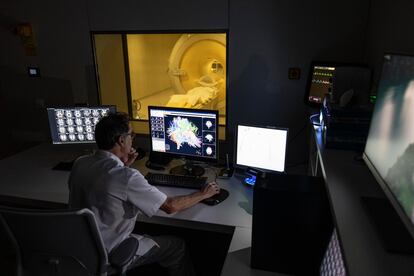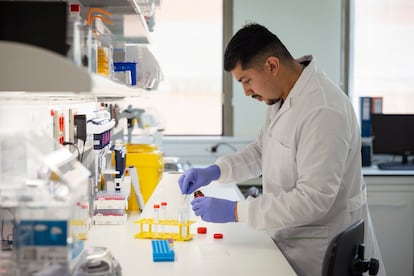Can science predict dementia years in advance? The battle to get ahead of neurodegenerative diseases
Scientists are looking for biological markers that will shed light on the presence of the still-invisible disease as soon as possible, in order to develop preventive policies

An unprecedented revolution is underway in the field of neurodegenerative diseases. In this field — which medicine has struggled to address, lacking weapons to treat ailments that were detected too late, when the brain damage was already incurable — science has taken a path that is beginning to turn the tables. The most progress is being made in Alzheimer’s disease, but other neurological conditions are not far behind. For the first time, a generation of innovative treatments are beginning to illuminate the way to slow the progression of this form of dementia, and researchers are discovering signs in the brain that can be used as biomarkers to detect Alzheimer’s and other degenerative diseases in increasingly early stages. The scientific leap in early diagnosis is so promising that the possibility of predicting the disease long before symptoms appear or of even screening the population is no longer a mirage: it is still a long way off, but it is not impossible.
“We are seeing a paradigm shift in Alzheimer’s. Several revolutions are happening at the same time: the digital revolution; the new treatments, which have modest but robust efficacy; the change the nihilism that has existed in this field; and the plasma markers of the disease. Just seven years ago, there were editorials that said that we were not going to be able to predict Alzheimer’s, and now it is just the opposite. All these things will change the field,” says Juan Fortea, neurologist at the Sant Pau Hospital in Barcelona.
Where science has made a giant leap is in the knowledge of biomarkers: molecular signs that help identify the presence of the disease. In conditions such as Alzheimer’s, which for decades were largely diagnosed on clinical criteria (such as the analysis of characteristic symptoms, memory loss, for example), there are now also tests that locate biological traces of the disease and refine detection.
In the brains of people with Alzheimer’s, for example, there is a build-up of two proteins — beta amyloid and tau — which poison neurons until they kill them. In diagnostic contexts, these molecules serve as biochemical markers that neurologists can measure in the cerebrospinal fluid to identify the presence of the disease, explains Pascual Sánchez, secretary of the Behavior and Dementia Study Group of the Spanish Society of Neurology and director of the CIEN Foundation. “In patients with Alzheimer’s, tau is elevated and amyloid is decreased because it is sequestered in the brain and there is less of it in the cerebrospinal fluid.” The doctor also points out that nuclear medicine also has radioactive tracers — substances or molecules that allow doctors to visualize physiological processes — that “mark these proteins and with a PET test, they are detected in the brain.”
For now, traces of tau and amyloid continue to be the best biological markers of Alzheimer’s and work is underway to detect them in blood, so that with a simple blood test, these biochemical signs of the disease can be identified. “What we know is that proteins accumulate a long time before symptoms appear. If we do these tests, they begin to alter decades earlier. We know this because when we have analyzed patients with genetic Alzheimer’s [which accounts for less than 1% of all cases], in asymptomatic carriers of the mutation, these tests begin to be altered decades earlier,” says the president of the CIEN Foundation.
But does this mean that a person without any symptoms could take a test to predict whether they will develop Alzheimer’s in the future? Sánchez replies: “With this we could screen for Alzheimer’s, but it doesn’t make sense because we don’t have a tool to change the course of the disease. And when you can’t do something, it’s not recommended. As of today, it is not recommended for anyone who is asymptomatic. The only case in which it would be justified is when there is suspicion of a mutation in family members.”
Fortea explains that predicting the disease is a complex issue: “It’s one thing is to diagnose and another to predict. A test is done within the context of application and doing one on a healthy person is not the same as doing one on a person with symptoms.”
He explains by way of example: “If a patient comes to me with a slight cognitive impairment, I do a memory test and I see that there are some deficiencies, I already know that that person has a 50% or 60% chance of have underlying Alzheimer’s. And if in that context, I apply a biomarker test and it is shown that they have [a buildup of these proteins], there is an association of these biomarkers with the disease. All this is a clinical-biological diagnosis.”
“Now,” he continues, “if a 60-year-old person comes in, who does not show any symptoms in the memory test, and when doing the biomarker test, I see the biomarkers of Alzheimer’s, I don’t know if they are going to develop it or not, nor when. The disease is very slow, it takes more than 20 years from when the protein accumulates until symptoms develop. This person can die with the biomarkers of Alzheimer’s, but without the disease developing.” He adds another analogy: “Not everyone with high cholesterol is going to suffer a myocardial infarction.”
Being able to predict Alzheimer’s in the long term “will take time,” says Fortea. “The tests are not sensitive and specific enough in a preclinical context [without symptoms]. They work much worse. And no one is yet recommending doing population screening because we don’t know what to tell them either: one in three people over 65 years of age has amyloid in the brain, but if I don’t know what to tell them and I can’t prevent it, why am I going to do those tests?”
Path to early detection
However, the experts consulted point out that “this is the way”: moving towards increasingly earlier detection. Above all, after the appearance of the first generation of drugs that, although with limited results, manage to eliminate amyloid from the brain and slightly slow the course of the disease. “When neurodegeneration accumulates, even if there are no clinical symptoms, we must intervene. Dementia is only the last phase of the disease. The same biomarkers can lead us to early detection: with a simple analysis, we can detect the disease early and develop preventive policies. The emergence of new treatments, combined with biomarkers that work, allow us to open a therapeutic window with drugs or changes in lifestyle,” says Arcardi Navarro, director of the Pasqual Maragall Foundation and the Barcelonaβeta Brain Research Center.
The search for tools for prevention is already underway. There are studies that are testing lecanemab — one of the new drugs against Alzheimer’s — in asymptomatic people with high biomarkers, says Navarro: “If it works, it could be a useful drug to stop or delay the afppearance of clinical symptoms. And maybe it makes sense to give it to a group of people at risk.”

Sánchez adds, however, that this approach is not so simple either, since Alzheimer’s is a very complex disease and is usually accompanied by other pathologies that feed back into this neurodegenerative disease: “If we had to do a screening and there was a treatment, the most robust thing to do is to go look for amyloid and tau. But it probably would not be enough because this disease is complex and although we can measure this protein, there are others that we cannot. In Alzheimer’s we need a lot of artillery and just [addressing] amyloid will not be enough. We have to delve deeper into the disease.”
We must advance on all fronts simultaneously, leaving none behind, Sánchez insists: “We must develop new biomarkers for other proteins and diagnose accurately. We have to be ready for when we can completely change the course of the disease.” Navarro agrees: “We must improve early detection systems and determine things that are not known today. For example: refine types of biomarkers, ages and regularity, how often they would be measured.”
The presence of amyloid and tau are the strongest biological signals, but not the only ones. British research published in Nature Mental Health, for example, has delved into the study of new biomarkers in Alzheimer’s and, after analyzing the brains of a hundred people through an MRI, found alterations in the connectivity of an area of the brain related to memory. These signals helped predict, up to nine years in advance, which participants were going to develop dementia. “This is proof of concept that we can detect things before they appear,” says Fortea. But he clarifies that this is only a first step and caution is needed: “It is difficult for me to think that we will diagnose with functional magnetic resonance imaging or proteomics. The value of this type of study is to push the field toward diagnostic capacity.”
We have to be prepared for when we can completely change the course of the diseasePascual Sánchez, spokesperson of the Spanish Society of Neurology.
Sebastian Walsh, a public health researcher at the University of Cambridge, called the results of this study “potentially exciting,” but highlighted several caveats, such as the fact the sample was “small” and the average time between the brain scan and diagnosis was only 3.7 years, meaning “it is not surprising that the ‘new’ cases of dementia actually had cognitive impairment at the time of the scans.” “Before we can be truly confident that this technology can predict dementia onset (rather than just be an early indicator it is present), it will be really important to see these findings demonstrated in bigger samples with a much longer delay between scan and onset of cognitive symptoms,” he said in statements to the scientific website Science Media Center.
Early detection in Parkinson's
Alzheimer’s is the disease where research in early diagnosis and prediction is most advanced, but other neurodegenerative diseases are following in its wake. A study published in Nature Communications has also opened the door to predicting, through a blood test, the onset of Parkinson’s symptoms years in advance in people who show initial symptoms associated with the disease. After analyzing the plasma proteins of a hundred participants — including people with Parkinson’s, individuals with REM sleep behavior disorder, which is an early phase of the disease, and a healthy control group — the researchers identified a handful of proteins that altered conditions associated with the neurodegenerative condition. Through a deep learning model, they predicted, with 79% accuracy and seven years in advance, the participants with premotor symptoms who would end up developing motor symptoms (slowness of movement, difficulty walking and muscle stiffness).
Sánchez welcomes the investigation, but points out that, in this case, researchers are not starting from scratch. “It is about diagnosing the disease in the premotor phase, but there is already a clinical diagnosis [REM sleep behavior disorder],” he points out. The authors, for their part, defend their finding. “We need objective biomarkers for early/pre-motor disease stages to be able to intervene and slow the underlying neurodegenerative process,” the study states. “This specific blood panel indicates molecular events in early stages and could help identify at-risk participants for clinical trials aimed at slowing/preventing motor Parkinson’s disease.”
In Parkinson’s, as in Lewy body dementia (LBD), there is a buildup of the same protein: alpha-synuclein. These are ailments that affect one another: in some patients, these abnormal deposits of alpha-synuclein (Lewy bodies) cause the disease to appear with motor symptoms (Parkinson’s) that, over time, can end in dementia. In other cases, the onset of the disease is a cognitive condition, with memory loss and hallucinations (Lewy body dementia), and then the patient also ends up developing slowness of movement and difficulties in walking.
Sánchez points out that there are lines of research to try to detect Lewy bodies, but there is still no way to early identify these deposits in a general way. “There is a tool under investigation, RT-QuIC, that is used to detect prion proteins [such as the devastating Creutzfeldt-Jakob disease], and it is now being tested to measure alpha-synuclein, but it is a very experimental technique.” For these diseases, he points out, there is still no molecular diagnosis available.
The investigation is advancing at various speeds. “We are beginning to be able to detect the proteins that accumulate in the brain and cause the main neurodegenerative diseases, although in Alzheimer’s we have an advantage. But we are beginning to glimpse the possibility of detecting them years away,” says Fortea. The Sant Pau neurologist has participated, precisely, in international research that has identified new biomarkers in blood (such as the TDP-43 protein, which accumulates in other neurodegenerative diseases) to detect amyotrophic lateral sclerosis, progressive supranuclear palsy and frontotemporal dementia: “This is the first time we can diagnose TDP-43 in ALS and frontotemporal dementia. The study is complex, but it breaks the ice. We did this in Alzheimer’s at the end of the 1990s,” he says.
When Spanish politician Pasqual Maragall announced in 2007 that he had Alzheimer’s, he proclaimed: “Nowhere is it written that this disease is invincible.” There is a long way to go to achieve this ambitious goal, but this time, Navarro is more confident about the future: “We are in a moment of cautious optimism.”
Sign up for our weekly newsletter to get more English-language news coverage from EL PAÍS USA Edition
Tu suscripción se está usando en otro dispositivo
¿Quieres añadir otro usuario a tu suscripción?
Si continúas leyendo en este dispositivo, no se podrá leer en el otro.
FlechaTu suscripción se está usando en otro dispositivo y solo puedes acceder a EL PAÍS desde un dispositivo a la vez.
Si quieres compartir tu cuenta, cambia tu suscripción a la modalidad Premium, así podrás añadir otro usuario. Cada uno accederá con su propia cuenta de email, lo que os permitirá personalizar vuestra experiencia en EL PAÍS.
¿Tienes una suscripción de empresa? Accede aquí para contratar más cuentas.
En el caso de no saber quién está usando tu cuenta, te recomendamos cambiar tu contraseña aquí.
Si decides continuar compartiendo tu cuenta, este mensaje se mostrará en tu dispositivo y en el de la otra persona que está usando tu cuenta de forma indefinida, afectando a tu experiencia de lectura. Puedes consultar aquí los términos y condiciones de la suscripción digital.
More information
Archived In
Últimas noticias
The journal ‘Science’ criticizes Trump’s anti-renewable energy policy: ‘The US is failing to benefit from its own innovations’
Cubans hope for a miracle as dengue and chikungunya spread
The long shadow of the father figure in the films of Rob Reiner
US sanctions against jailed cartel leader ‘El Marro’ highlight Mexico’s lack of control over its prisons
Most viewed
- Christian Louboutin: ‘Young people don’t want to be like their parents. And if their parents wear sneakers, they’re going to look for something else’
- Cartels in Mexico take a leap forward with narco-drones: ‘It is criminal groups that are leading the innovation race’
- ‘El Limones’ and the growing union disguise of Mexican organized crime
- The low-cost creative revolution: How technology is making art accessible to everyone
- ‘We are dying’: Cuba sinks into a health crisis amid medicine shortages and misdiagnosis











































